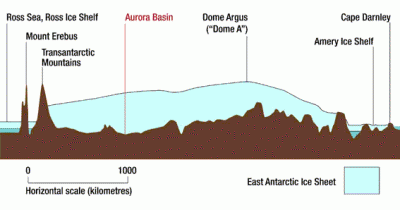The world’s ice sheets are our best record of what the climate was like thousands of years ago. Now an international team has begun the search for a million-year ice core from the continent’s deepest ice. [30 December 2008 | Peter Boyer]
While you’re enjoying your festive season here in temperate Tasmania, spare a thought for eight intrepid Australians spending their summer high on the Antarctic icecap in a multi-year quest for the world’s oldest ice.

A profile of the East Antarctic Ice Sheet showing the continental rock below the ice. In Aurora Basin this rock is below sea level.
The Australians, led by glaciologist Dr Mark Curran of the Tasmanian-based Australian Antarctic Division, are part of a 12-strong international ice-drilling team that includes scientists from Denmark and the United States.
This summer the team is based in Aurora Basin, a large depression in the rocky terrain that underlies the vast East Antarctic ice sheet, 600 km inland from the Australian station of Casey.
The rocks of Aurora Basin are below sea level. The ice sheet above is well over four kilometres thick, and the ice at its base formed from falling snow around a million years ago. As the snow fell, it trapped tiny bubbles of air, each bubble a micro-record of Earth’s atmosphere at the time.
The climate history of our 4.5-billion-year-old planet has been attracting a lot of attention in recent years, as scientists grappling with the implications of today’s changing climate seek to put this in a longer-term context.
To study the climate in very early times of Earth’s history, scientists analyse ancient rocks. These indicate atmospheres very different from now, with carbon dioxide levels often several times those of today and atmospheric oxygen virtually non-existent.
Studies of isotopes in sedimentary rocks have indicated that over millions of years carbon dioxide levels fluctuated greatly, but around 35 million years ago they began to drop and by about 20 million years ago had stabilised to between 200 and 350 parts per million.
Ice cores give a much clearer picture of the changing composition of our atmosphere, though over a much shorter time span. So far, drilling teams in Greenland and Antarctica, the world’s two largest ice sheets, have recovered ice cores dating back about 650,000 years.
These cores show that carbon dioxide levels in the atmosphere varied between about 180 parts per million, during ice ages, and 290 parts per million, in warmer times between the ice ages.
One aim of this international program is to obtain an array of ice core records covering the past 2000 years. Ice records show that for most of this time the level of atmospheric carbon dioxide was fairly steady, but in the 1800s began to climb. It’s now increasing at a rate not seen in the entire 650,000 years of the ice record, and now stands at over 380 parts per million.
The drilling will also help explore what seems to be a link between Antarctic snowfall and the climate of south-western Australia, first identified by Hobart-based glaciologist Dr Tas van Ommen, a member of the Aurora drilling team. This study will be helped by current snowfall data from a new automatic weather station to be left at the drill site.
The complexities of drilling so deep in such a remote place mean that we’re still a few years away from the million-year ice record, but at least the group won’t have to put up with a long wait for data from their ice cores – a real problem for past drilling programs.
New instruments developed by US scientist Dr Joe McConnell (also a member of the Aurora team) produce ice-core data within months, a process that previously took many years. Time is our enemy in the battle against climate change, so this is something to applaud.
